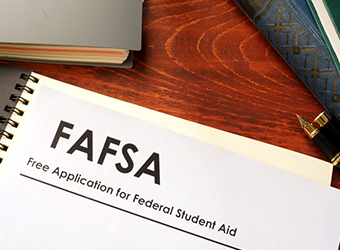 Guest presenter: Pedro Hernandez, Director of Outreach Services, Office of Student Financial Assistance, Florida Department of Education
Guest presenter: Pedro Hernandez, Director of Outreach Services, Office of Student Financial Assistance, Florida Department of Education
FCAN host: Adriana Pavicic, Community Engagement Coordinator
Florida is currently 48th in the nation in FAFSA completions, which is a precipitous drop from 32nd place last fall.
It is imperative that the state’s FAFSA figures rebound given that Florida’s high school graduating class misses out on over $300 million in Pell Grant dollars every year by not completing the federal financial aid form. The FAFSA also helps students access aid at a variety of institutions once they graduate high school, including some technical college and career programs.
On March 10, FCAN hosted a webinar highlighting the FAFSA data-sharing agreement offered by the Florida Department of Education’s Office of Student Financial Assistance (OSFA), and how it can help counselors ensure that students submit an error-free FAFSA.
Why the FAFSA data-sharing agreement matters
Pedro Hernandez, Director of Outreach Services for OSFA, provided some background on the FAFSA data-sharing agreement.
“In order to provide student data to the districts and high schools, the U.S. Department of Education requires a data sharing agreement between the Florida Department of Education/OSFA and each school district,” Hernandez said. Yet over 60% of webinar attendees were not sure if their district had the agreement in place and didn’t know they could access student-level completion information.
With the student-specific data the agreement makes possible, counselors have the ability to provide one-on-one support for students completing the FAFSA. According to the National Center for Education Statistics (NCES), first-generation students and students from low-income households are less likely to complete the application.
For counselors to know which students may need support, access to student-level FAFSA completion fields is essential.
What to do with student-level FAFSA information
In school districts with a data-sharing agreement in place, counselors can log on to FloridaStudentFinancialAidsg.org to view FAFSA and/or Florida Financial Aid Application (FFAA) completion reports for their specific schools.
The information in the completion reports allows counselors to:
- Review the total amount of FAFSAs completed at their school
- See which students have submitted or completed the FAFSA
- Provide targeted outreach to students who may need extra support with the process
With these details, counselors can connect with students who may have thought they were done but missed a crucial step along the way, such as a signature — one of the most common mistakes made when filling out the FAFSA.
This assistance allows students to finalize and confirm any information on the form in order to receive the financial aid they are eligible for and continue their education beyond high school.
“Keep reminding the students that this is just a step in helping them reach the ultimate goal,” Hernandez said. “This is a process, and we’ll assist them with achieving their maximum capabilities.”
Requesting a data-sharing agreement is easy as 1, 2, 3
FCAN encourages all school districts to complete a data-sharing agreement with the Florida Department of Education. The following districts do not currently have the agreement in place:
If a district is interested in putting the agreement in place, this can be accomplished in three simple steps:
- Contact Pedro Hernandez, OSFA Director of Outreach Services for an application. Provide the names of the current school district superintendent, chair of the school board, and district legal counsel.
- Once the data sharing agreement is provided, the signatures of those individuals will be needed.
- Submit the signed electronic copy for immediate access to your district’s student-level data. Mail the hard copy within 30 days of submitting the electronic copy to:
Pedro Hernandez
Office of Student Financial Assistance
325 W. Gaines St., Suite 944
Tallahassee, FL 32399
System limitations
While the tool is useful to offer assistance for students who need it, it does have limitations.
Currently, the system uses a student’s Social Security number (SSN) to match to the student record. If a student does not enter an SSN, the system cannot match them. There are also districts moving away from requiring an SSN in the student record, which will impact this match process. The state is working to create additional identifiers that can match a FAFSA to a student record.
The district gives directives to which schools can access the information, so if your district has the agreement in place but you do not have access to the FAFSA fields, you need to contact your district to gain access.
For any additional questions — or if you have new personnel that need training — contact Pedro Hernandez.
Show Notes
To view the full webinar presentation, download the slide deck.
Be sure to visit our Past Webinars page for access to recordings and downloadable material from FCAN’s previous presentations.

